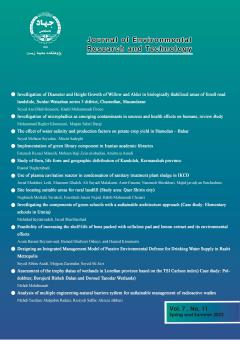Assessment of trophy status of wetlands in Lorestan province based on Carlson TSI index( Case study: Poldokhtar wetlands, Borujerd corridor and Tanodar Doroud wetlands)
Subject Areas : آلودگی منابع آب
1 -
Keywords: Keywords: Trophy, Lorestan Province, Wetland, Carlson TSI,
Abstract :
Determining the trophy status is one of the assessment and analysis methods of the ecological balance of wetland ecosystems, because the sustainability and continuity of productivity based on these unique ecosystems requires proper monitoring management and control their environmental conditions because increasing nutrients affect all levels of aquatic ecosystems, including changes in species abundance, migration, reduction of biodiversity, and changes in the structure and composition of communities. Therefore, a suitable method should be used to determine the trophy status, or in other words, the production capacity of an ecosystem. Conventional methods for determining the amount of trophy are based on three physical, chemical and biological parameters. Lorestan province due to its unique construction has unique wetlands, including 11 Poldokhtar wetlands with an area of 142.7 hectares, Bishe Dalan wetland with 913.5 hectares and Tanodar wetland with an area of 1000 hectares. In this study, to evaluate the trophy status, sampling of phosphorus (TP), total nitrogen (TN) concentration or Carlson trophy index (TSI) was used in Poldokhtar, Bishe Dalan and Tanodar for summer and winter of 2019. Based on the annual average of Carlson index, Poldakhtar and Bishe Delan wetlands are in mild mesotrophic trophy conditions and Tanodar wetland is in the eutrophic category. In the wetlands of Lorestan province, the sediment load of suspended solids and water turbidity have been exceeded these wetlands limits and has had destructive effects on the unstable wetlands` body due to the annual entry of large amounts of sediment from the catchment, development of gardens, various recreational withdrawals in Boroujerd and Doroud, increasing the level of river water pollution caused by municipal and industrial wastewater, also, wastes from city and rural recreation centers and wastes from point sources of pollution such as warm water fish breeding ponds.
امینی هرندی، سمانه؛ و احمدی ندوشن، مژگان(1398) بررسی وضعیت تغذیه گرایی تالاب بین المللی امیر کلایه به منظور مدیریت و حفاظت از آن، فصلنامه محیط زیست جانوری، سال یازدهم، شماره 4، زمستان، 350- 345.
جباری، حجت؛ و منتصری، مجید(1399) بررسی شرایط تروفی تالاب کانی برازان مهاباد با استفاده از فسفر زیست فراهم رسوبات و شاخص کارلسون(TSI)، تحقیقات کاربردی خاک، جلد 8، شماره 1، بهار، 148- 136.
درویش صفت، علی اصغر؛ جمالزاده فلاح، فریبرز؛ و نظامی بلوچی، شعبان علی.(1378) بررسی وضعیت تروفی تالاب انزلی با استفاده از GIS و شاخص تروفی TSI، مجله محیط شناسی، 25(23): 10- 1.
صمدی، جواد (1394) بررسی تأثیر مکانی- زمانی کمی و کیفی پسابهای کاربری اراضی بر آلودگی تالاب چغاخور با استفاده از شاخص IRWQI و روشهای آماری، فصلنامه تحقیقات منابع آب ایران، 11 (3): 171- 159.
فلاح، مریم؛ پیرعلی زفره یی، احمد رضا؛ و ابراهیمی درچه، عیسی(1397) ارزیابی وضعیت تروفی تالاب بین المللی انزلی با استفاده از شاخص کارلسون(TSI)، مجله پژوهش آب ایران، 12(1) 28: 29- 21.
مهدی نسب، مهدی.(1398) ارزیابی تروفی بر اساس شاخص کارلسون(TSI) مطالعه موردی: تالابهای دائمی شهرستان پل دختر، مجله علمی شیلات ایران، سال 28، شماره 2، 185- 179. DOI: 10.22092/ISFJ. 2019.119110
Alobaidy, A.H., Abid, M.J., and Maulood, H.S. 2010. Application of water quality index for assessment of Dokan Lake ecosystem, Kurdistan Region, Iraq. Water Resource and Protection. 2: 792-798.
Brönmark, C. and Hansson, L.A., 2005. Translated by Hoseyni N. The biology of lakes and ponds. Second edition. 300p.
Ejankowski, W., and Lenard, T., 2014. Trophic state of a shallow lake with reduced in flow of surface water, Archives of Environmental Protection. 14: 29-37.
Elmaci A., Ozengin N., Teksoy A., OlcayTopac A., and Savas Baskaya H. 2009. Evaluation of Trophic state of lake Uluabat, Turkey. Journal of Environmental Biology, 30(5): 757-760.
Kumar, P., Mahajan, A. K. and Meena, N. K., 2019. Evaluation of trophic status and its limiting factors in the Renuka Lake of Lesser Himalaya, India. Environmental Monitoring and Assessment, 191: 3-11.
Lenard, T., and Solis, M., 2009. Trophic diversity of three deep lakes– Piaseczno, Rogóźno and Krasne – in the years 2006–2007. Teka Komisji Ochrony I Kształtowania Środowiska Przyrodniczego.
200(6): 162-169.
Nixon, S and Trent, Z., 2003. Europe’s water: An indicator-based assessment, European environment agency
Nyenje, P.M., Foppen, J.W., Uhlenbrook, S., Kulabako, R., and Muwanga, A. 2010. Eutrophication and nutrient release in urban areas of sub-Saharan Africa - A review. Science of the Total Environment.408: 447-455.
Padisak, J., Borics, G.A., Feh´er, G., Grigorszky, I.A., Oldal, I., Schmidt, A., and Zambone-Doma, Z. 2003.Dominant species, functional assemblages and frequency of equilibrium phases in late summerphytoplankton assemblages in Hungarian small shallow lakes. Hydrobiologia. 502: 157-168.

